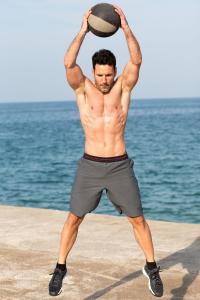The Brookbush Institute Publishes NEW Updates: 'Glossary: Stretch Shortening Cycle, Course: Power Training'
The Brookbush Institute continues to enhance education with new courses, a modern glossary, an AI Tutor, and a client program generator.
- Additional Glossary Term: Stretch-Shortening Cycle
- Prepare for the Brookbush Institute: Certified Personal Trainer (CPT) Certificate
INTRODUCTION TO POWER TRAINING AND HIGH-VELOCITY EXERCISE: A COMPREHENSIVE CONTINUING EDUCATION APPROVED COURSE
Power training is a specialized form of strength training that emphasizes the development of high-velocity movements. This course presents an in-depth investigation of power training principles, with applications for enhancing sport-specific performance, optimizing rehabilitation outcomes, and improving functional capacity across diverse populations.
Designed for movement and health professionals, this course reviews the evidence supporting power training and provides practical guidance for its integration into exercise program design.
COURSE OVERVIEW
Power training is distinct from traditional strength training in that it prioritizes movement speed over maximal load. The primary goal is to enhance explosive performance, such as sprinting, jumping, throwing, and rapid lifting, through the development of neuromuscular adaptations that support high rates of force development.
This course includes a comprehensive systematic research review, exploring:
- Neural adaptations specific to high-velocity strength training
- Muscle morphology changes, including fiber-type adaptations and tendon behavior
- Hormonal responses, both acute and chronic, to power-focused resistance training
- Comparative effectiveness of traditional strength training and power training strategies
- Evidence-based recommendations for acute variables: repetition range, intensity, rest intervals, set volume, training frequency, and velocity-specific cueing
The review also highlights counterintuitive findings, such as:
- Bodyweight and light load exercises may outperform barbell-loaded exercises for improving movement velocity
- Olympic lifts may not be the most effective choice for all populations seeking power development.
BROOKBUSH INSTITUTE POSTITION STATEMENT ON POWER TRAINING
A combination of max strength and power training is likely ideal for improving high-velocity activity performance. When training specifically for power (maximum velocity and speed), repetition velocity is the most important acute variable. Further, repetitions should include a stretch-shortening cycle and a force-velocity curve that is analogous to the activities being trained for. Generally, this implies that power training repetitions should include a quick eccentric load, an amortization phase, a follow-through (no deceleration to stay on the ground or hold on to an object), and soft catches and landings. Load should be limited to the amount of resistance that can be used without decreasing velocity. Research implies that ideal acute variable recommendations for power exercise are 3-5 sets/muscle group and 3-10 repetitions/set, performed until velocity decreases.
FREQUENTLY ASKED QUESTIONS (FAQs)
What is meant by power training?
- Power training refers to a category of strength training designed to enhance the ability to generate force rapidly. In biomechanics, power is defined as Force × Distance / Time, making power training distinct from traditional resistance training by prioritizing movement velocity over maximal load. Power training is commonly used to improve performance in activities such as sprinting, jumping, throwing, and explosive lifting.
What type of training is best for power?
- The most effective power training includes high-velocity resistance exercises that incorporate a rapid eccentric contraction, a short amortization phase, and an explosive concentric phase with follow-through (e.g., jump, throw, or release). Examples include plyometric drills , medicine ball throws , ballistic push-ups , and depth jumps . Research suggests that bodyweight or lightly loaded exercises performed at maximal speed may be more effective than heavy lifts for developing power, especially when the goal is to shift the force-velocity curve.
Does power training build muscle?
- Power training can result in modest hypertrophy, but it is not primarily designed for muscle growth. The adaptations are more neurological and functional, including increased motor unit recruitment, improved rate of force development (RFD), and better intermuscular coordination. While some muscle fiber adaptations occur, particularly in fast-twitch fibers, power training is not a substitute for hypertrophy-specific protocols when the primary goal is muscle mass.
How is power training different from strength training?
- While both power and strength training involve resistance, their objectives and loading strategies differ. Strength training focuses on maximal force production, typically with slower movement speeds and heavier loads (e.g., 3-6 RM). Power training emphasizes movement speed and explosiveness, using lighter loads or bodyweight and targeting velocity adaptations. The neuromuscular and hormonal responses also differ between these two approaches.
Can beginners safely perform power training?
- Yes, with appropriate progression and instruction. Beginners can start with low-impact plyometric movements and bodyweight exercises emphasizing control, landing mechanics, and safe deceleration. As movement quality improves, progression to higher velocity and more complex patterns can be implemented. Structured regressions and cueing strategies are essential to reduce injury risk while maximizing benefit.
PRE-APPROVED CREDITS FOR:
- Certified Personal Trainer (CPT) Certificate
PRE-APPROVED CONTINUING EDUCATION CREDITS FOR:
- Athletic Trainers
- Chiropractors
- Group Exercise Instructors
- Massage Therapists
- Occupational Therapists - Intermediate
- Personal Trainers
- Physical Therapists
- Physical Therapy Assistants
- Physiotherapists
THIS COURSE INCLUDES:
- AI Tutor
- Study Guide
- Text and Illustrations
- Audio Voice-over
- Research Review
- Technique Videos
- Sample Routine
- Practice Exam
- Pre-approved 3 Credit Final Exam
FOR THE FULL TEXT AND SO MUCH MORE, CLICK ON THE LINK
Brent Brookbush
Brookbush Institute
+ +1 2012069665 ext.
email us here
Visit us on social media:
Facebook
X
LinkedIn
Instagram
YouTube
TikTok
Other
Legal Disclaimer:
EIN Presswire provides this news content "as is" without warranty of any kind. We do not accept any responsibility or liability for the accuracy, content, images, videos, licenses, completeness, legality, or reliability of the information contained in this article. If you have any complaints or copyright issues related to this article, kindly contact the author above.
Dr. Kevin Sadati Present his Preservation Facelift Technique at Vegas Cosmetic Surgery and UC Irvine
New York Cosmos Relaunches as Fan-Owned, City-Driven Club
MRC Restoration Responds in 25 Minutes to Water Leak, Prevents Major Damage for Bonne Terre Homeowner
Kalendarium
Więcej ważnych informacji
 Jedynka Newserii
Jedynka Newserii

 Jedynka Newserii
Jedynka Newserii

Prawo

Trwają dyskusje nad kształtem unijnego budżetu na lata 2028–2034. Mogą być rozbieżności w kwestii Funduszu Spójności czy dopłat dla rolników
Trwają prace nad wieloletnimi unijnymi ramami finansowymi (WRF), które określą priorytety wydatków UE na lata 2028–2034. W maju Parlament Europejski przegłosował rezolucję w sprawie swojego stanowiska w tej sprawie. Postulaty europarlamentarzystów mają zostać uwzględnione we wniosku Komisji Europejskiej w sprawie WRF, który zostanie opublikowany w lipcu 2025 roku. Wciąż jednak nie ma zgody miedzy państwami członkowskimi, m.in. w zakresie Funduszu Spójności czy budżetu na rolnictwo.
Konsument
35 proc. gospodarstw domowych nie stać na zakup mieszkania nawet na kredyt. Pomóc może wsparcie budownictwa społecznego i uwolnienie gruntów pod zabudowę

W Polsce co roku oddaje się do użytku ok. 200 tys. mieszkań, co oznacza, że w ciągu dekady teoretycznie potrzeby mieszkaniowe społeczeństwa mogłyby zostać zaspokojone. Jednak większość lokali budują deweloperzy na sprzedaż, a 35 proc. gospodarstw domowych nie stać na zakup nawet za pomocą kredytu. Jednocześnie ta grupa zarabia za dużo, by korzystać z mieszkania socjalnego i komunalnego. Zdaniem prof. Bartłomieja Marony z UEK zmniejszeniu skali problemu zaradzić może wyłącznie większa skala budownictwa społecznego zamiast wspierania kolejnymi programami zaciągania kredytów.
Problemy społeczne
Hejt w sieci dotyka coraz więcej dzieci w wieku szkolnym. Rzadko mówią o tym dorosłym

Coraz większa grupa dzieci zaczyna korzystać z internetu już w wieku siedmiu–ośmiu lat – wynika z raportu NASK „Nastolatki 3.0”. Wtedy też stykają się po raz pierwszy z hejtem, którego jest coraz więcej w mediach społecznościowych. Według raportu NASK ponad 2/3 młodych internautów uważa, że mowa nienawiści jest największym problemem w sieci. Co więcej, dzieci rzadko mówią o takich incydentach dorosłym, dlatego tym istotniejsze są narzędzia technologiczne służące ochronie najmłodszych.
Partner serwisu
Szkolenia

Akademia Newserii
Akademia Newserii to projekt, w ramach którego najlepsi polscy dziennikarze biznesowi, giełdowi oraz lifestylowi, a także szkoleniowcy z wieloletnim doświadczeniem dzielą się swoją wiedzą nt. pracy z mediami.









.gif)

 |
| |
| |
|